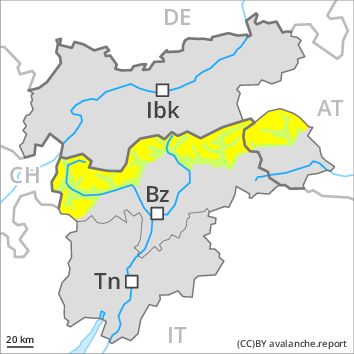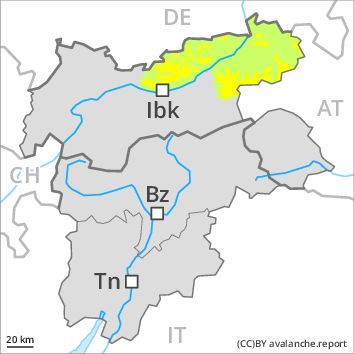Regions
Eastern Pfunderer Mountains, Durreck Range, Western Rieserferner Mountains, Val Müstair Alps, Langtaufers, Ortler Range, Schnals Ridge, Southern Stubai Alps, Venediger Range, Southern Zillertal Alps and High Tauern, Eastern Rieserferner Mountains, Saldurn-Mastaun Ridge, Glockner Range, Texel Mountains, Western Pfunderer Mountains

Danger level
Danger Level 2 - Moderate above 2200m
Danger Level 1 - Low above 2200m
Avalanche Problem
Wind-drifted snow above 2200m, N-NE-E-SE-S-NW
Persistent weak layer above 2800m, N-NE-E-W-NW

Fresh wind slabs require caution, in particular at high altitudes and in high Alpine regions.
Fresh and somewhat older wind slabs can be released by a single winter sport participant in some cases in particular on northwest to north to south facing aspects above approximately 2200 m. In some cases avalanches are medium-sized. These avalanche prone locations are clearly recognisable to the trained eye.
Weakly bonded old snow: In isolated cases avalanches can be released in the old snowpack and reach dangerously large size. Caution is to be exercised in particular at transitions from a shallow to a deep snowpack in little used backcountry terrain.
Snowpack
dp 6: cold, loose snow and wind
Some snow has fallen in some regions. The fresh and older wind slabs are to be evaluated with care and prudence on steep shady slopes at high altitudes and in high Alpine regions. Faceted weak layers exist in the old snowpack. The snowpack will be subject to considerable local variations. In steep terrain there is a danger of falling on the hard snow surface.
Tendency
The backcountry touring conditions are generally favourable. The fresh and somewhat older wind slabs are mostly small and can only be released in isolated cases. In some cases relatively hard layers of snow are lying on old snow containing large grains. Faceted weak layers exist deep in the snowpack in particular in shady places that are protected from the wind. The snowpack will be subject to considerable local variations. On south and southwest facing slopes thus far only a little snow is lying in all altitude zones.
Regions
Karwendel Mountains, Brandenberg Alps, Western Kitzbühel Alps, Wilder Kaiser Mountains - Waidring Alps, Eastern Kitzbühel Alps

Danger level
Danger Level 2 - Moderate above 1600m
Danger Level 1 - Low above 1600m
Avalanche Problem
Wind-drifted snow above 1600m, N-NE-E-W-NW

Fresh and older wind slabs require caution.
As a consequence of a freshening westerly wind, mostly small wind slabs formed adjacent to ridgelines on northwest, north and northeast facing slopes. Caution is to be exercised in particular on shady slopes as well as adjacent to ridgelines and in gullies and bowls above approximately 1600 m.
Weakly bonded old snow requires caution, especially on very steep shady slopes as well as on wind-loaded slopes. The avalanches are rather small and can mostly only be released by large loads.
Snowpack
dp 6: cold, loose snow and wind
The sometimes strong wind will transport the snow.
Faceted weak layers exist in the old snowpack in particular on shady slopes. The snowpack will be subject to considerable local variations.
Tendency
Slight increase in avalanche danger as a consequence of the fresh snow.
Regions
Weißkugel Range, Western Verwall Mountains, Gurgler Range, Eastern Verwall Mountains, Central Stubai Alps, Silvretta, Northern Zillertal Alps, Allgäu Alps, Samnaun Mountains, Eastern Lechtal Alps - Ammergau Alps, Northern Oetz and Stubai Alps, Mieming Mountains, Western Tuxer Alps, Eastern Tuxer Alps, Western Lechtal Alps, Glockturm Range, Central Lechtal Alps, Grieskogel Mountains

Danger level
Danger Level 2 - Moderate above 2000m
Danger Level 1 - Low above 2000m
Avalanche Problem
Wind-drifted snow above 2000m, N-NE-E-W-NW

Fresh wind slabs represent the main danger.
Fresh and somewhat older wind slabs can be released by a single winter sport participant in isolated cases above approximately 2000 m. Avalanche prone locations are to be found in particular on very steep west, north and east facing slopes above approximately 2000 m. These avalanche prone locations are clearly recognisable to the trained eye. Caution is to be exercised adjacent to ridgelines. Weakly bonded old snow requires caution. Caution is to be exercised in particular at transitions from a shallow to a deep snowpack in little used backcountry terrain. Avalanches can be released, in particular by large loads and reach medium size. Dry avalanches are rather small.
Snowpack
dp 6: cold, loose snow and wind
As a consequence of fresh snow and a moderate to strong wind from westerly directions, rather small wind slabs formed in particular adjacent to ridgelines as well as above approximately 2000 m. In many cases fresh snow is lying on a hard crust.
The fresh and somewhat older wind slabs are in some cases prone to triggering in particular on very steep shady slopes above approximately 2000 m. Faceted weak layers exist in the old snowpack, in particular between approximately 2400 and 3000 m.
The snowpack will be subject to considerable local variations.
Tendency
Slight increase in avalanche danger as a consequence of the fresh snow.
Regions
Sexten Dolomites, Latemar, Southern Adamello, Sarntal Alps, Adamello - Presanella, Northern Brenta - Peller, Bondone and Stivo, Folgaria - Laverone, Southern Brenta, Southern Lagorai, Northern Lagorai, Maddalene, Pine' - Mocheni Valley, Western Deferegger Alps, Ulten Valley, Eastern Nonsberger Alps, Northern Dolomites of Fiemme, Gröden Dolomites, Primiero - Pale di S. Martino, Eastern Deferegger Alps, Prags Dolomites, Prealps, Schober Mountains, Cembra Valley, Lienzer Dolomites, Vallarsa, Western Nonsberg Alps, Fassa Valley, Sole, Pejo and Rabbi, Ledro Valley, Paganella, Marzola - Valsugana

Danger level
Danger Level 1 - Low
Avalanche Problem
Wind-drifted snow above 2400m, N-NE-E-SE-NW

The old snowpack will be generally stable. Wind slabs are to be evaluated with care and prudence.
The rather small wind slabs have bonded quite well with the old snowpack. These can only be released by large loads in most cases. The avalanche prone locations are to be found in particular on northwest to north to southeast facing wind-loaded slopes above approximately 2400 m, especially in gullies and bowls, and behind abrupt changes in the terrain. These places are clearly recognisable to the trained eye.
In steep terrain there is a danger of falling on the hard snow surface.
Snowpack
dp 6: cold, loose snow and wind
The fresh and somewhat older wind slabs are mostly small and can only be released in isolated cases. In some cases relatively hard layers of snow are lying on old snow containing large grains. Faceted weak layers exist deep in the snowpack in particular in shady places that are protected from the wind. The snowpack will be subject to considerable local variations. On south and southwest facing slopes a little snow is lying in all altitude zones.
Tendency
The backcountry touring conditions are generally favourable.




